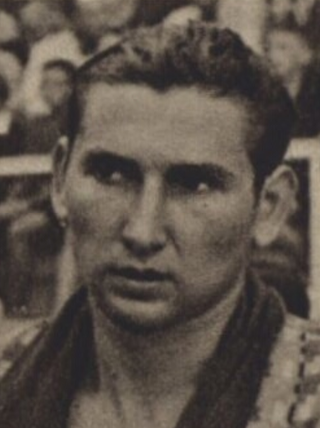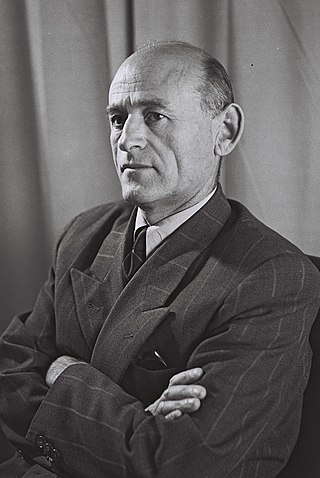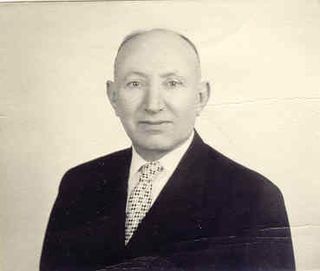
Duo Datz is a group comprising Orna and Moshe Datz. A musical duo in Israel for audiences of all ages, they were also introduced to European audiences by scoring a third place for Israel at the 1991 Eurovision Song Contest.

Tell Qasile is an archaeological site near the Yarkon River in Tel Aviv, Israel. Over 3,000 years old, the site contains the remains of a port city founded by the Philistines in the 12th century BC.

Esther Vilenska was a Lithuanian Jewish Israeli communist politician, journalist and author who served as a member of the Knesset for Maki between 1951 and 1959 and then again from 1961 to 1965.

The Abraham Avinu Synagogue is a synagogue in the Jewish Quarter of Avraham Avinu in Old City of Hebron in the State of Palestine. Built by Sephardic Jews led by Hakham Malkiel Ashkenazi in 1540, its domed structure represented the physical center of the Jewish Quarter of the Old City of Hebron. The synagogue became the spiritual hub of the Jewish community there and a major center for the study of Kabbalah. It was restored in 1738 and enlarged in 1864; the synagogue stood empty since the 1929 Hebron massacre, was destroyed after 1948, was rebuilt in 1977 and has been open ever since.

The Union Bank of Israel, Ltd. ; TASE: UNON), more widely known by its Hebrew name, Bank Igud, is the sixth largest Israeli bank, with thirty branches spread around the country.

Pavol Steiner, also Pavel Steiner and Paul Steiner was a Slovak Olympic water polo player and swimmer representing Czechoslovakia. He was also a cardiology surgeon. Steiner competed in the 1928 Summer Olympics in water polo, won a bronze medal at the 1931 European Aquatics Championships in swimming, and won five swimming gold medals and one water polo gold medal combined at the 1932 Maccabiah Games and 1935 Maccabiah Games in Mandatory Palestine.

Meir Argov was a Zionist activist, Israeli politician and a signatory of the Israeli declaration of independence.

Kfar Uria is a moshav in central Israel. Located near Beit Shemesh in the Shephelah. It falls under the jurisdiction of Mateh Yehuda Regional Council. In 2022 it had a population of 910.

The Justice Ministry is the Israeli government ministry that oversees the Israeli judicial system.
Manfred Aschner was an Israeli microbiologist and entomologist. Recipient of the Israel Prize in Life Sciences. He was a professor in the Faculty of Biotechnology and Food Engineering at the Technion.

Bank of Jerusalem, Ltd. is Israel's seventh largest bank, with total assets of 9,301 million shekels. Bank of Jerusalem is headquartered in Jerusalem and has 25 branches around the country.

Shmuel Mikunis was a communist Israeli politician and member of the Knesset from 1949 until 1974.
Danya Cebus is an Israeli construction company. It is a subsidiary of Africa Israel Investments. It was founded in 1997. It is active in Russia, Romania, and Israel.

The Plurinational State of Bolivia and the State of Israel first established a diplomatic relationship with each other in 1950, two years after the Israeli Declaration of Independence and one year after Bolivia recognized Israel's sovereignty. Both countries enjoyed generally stable and close ties until the beginning of the 21st century, when successive Bolivian governments became vocally opposed to Israeli military operations against Hamas in the Gaza Strip. Under the Bolivian political party Movement for Socialism, which has governed the country on a near-continuous basis since 2006, Bolivia has adopted an increasingly pro-Palestinian stance at the United Nations with regard to the Israeli–Palestinian conflict, eliciting a negative response from the Israeli government.
Morris "Tubby" Raskin was an American basketball player and coach. He played for the Brooklyn Arcadians in the American Basketball League (ABL). He later coached the men's basketball team at Brooklyn College, the Hartford Hurricanes in the ABL, the Israel men's national basketball team for Israel at the 1952 Summer Olympics, and the U.S. basketball team to a gold medal in the 1953 Maccabiah Games.

Tzvi Ayalon was a Haganah leader and a major general (Aluf) in the Israel Defense Forces, he served as the first Deputy Chief of General Staff as well as the commander of the Central Command (Israel). After his military service he served as the deputy director-general of the Ministry of Defense (Israel) and Ambassador of Israel in Romania.

The Har'el interchange was an interchange that connected Highway 1 and Road 3965 near the communities Mevaseret Zion and Motza Illit. The interchange was in the Diamond interchange type, whose bridge is built on the secondary road route and passes over Highway 1, where the traffic is continuous. The interchange opened to traffic in 1971, with the expansion project of Highway 1, which began in the late 1960s. The interchange is named after the Harel Brigade who fought in the area in the 1948 Palestine war.
The Israel Philatelic Federation is an association whose purpose is to nurture and promote philately in Israel.

Mordecai Margalioth (Margulies) (13 October 1909/28 Tishrei 5670–24 March 1968; Hebrew: מרדכי מרגליות) was a scholar of the Talmud, Midrash and Geonic literature. He was a professor at the Hebrew University of Jerusalem and at the Jewish Theological Seminary of America.

The First Wall is one of three strong and fortified walls that were built for the defense of Jerusalem during the Second Temple Period. This wall was built during the Hasmonean period, but its foundations are older and were laid already in the First Temple period. During the time of the Return to Zion, the wall was rebuilt by Nehemiah, and in the days of the Hasmoneans, it was strengthened and even additional parts of it were built. The additional walls are the Second Wall - built during the days of the Hasmonean rulers John Hyrcanus or Alexander Jannaeus, and the Third Wall - construction began in the days of Agrippa I, and its construction was completed on the eve of the Great Revolt.

















